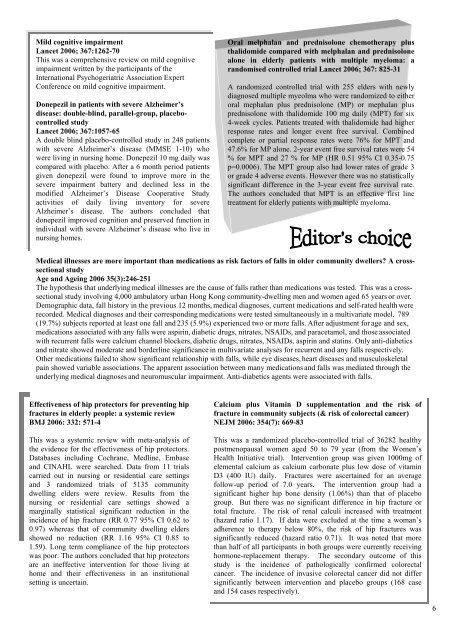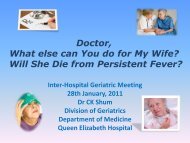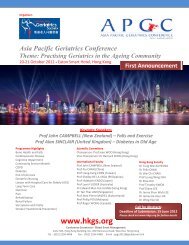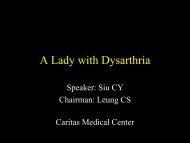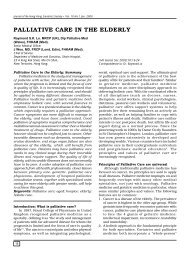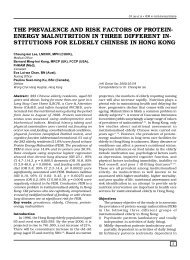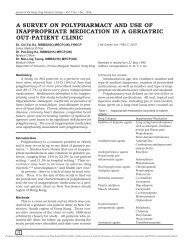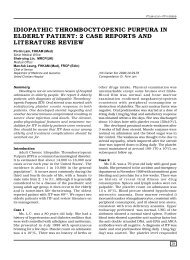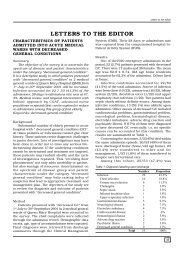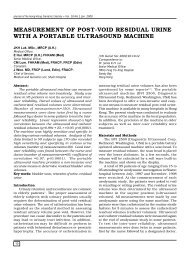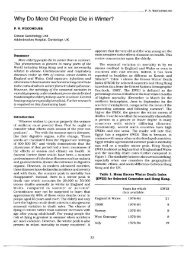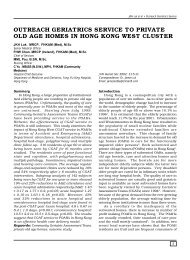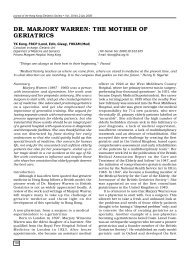The Hong Kong Geriatrics Society Newsletter May 2006
The Hong Kong Geriatrics Society Newsletter May 2006
The Hong Kong Geriatrics Society Newsletter May 2006
You also want an ePaper? Increase the reach of your titles
YUMPU automatically turns print PDFs into web optimized ePapers that Google loves.
Mild cognitive impairment<br />
Lancet <strong>2006</strong>; 367:1262-70<br />
This was a comprehensive review on mild cognitive<br />
impairment written by the participants of the<br />
International Psychogeriatric Association Expert<br />
Conference on mild cognitive impairment.<br />
Donepezil in patients with severe Alzheimer’s<br />
disease: double-blind, parallel-group, placebocontrolled<br />
study<br />
Lancet <strong>2006</strong>; 367:1057-65<br />
A double blind placebo-controlled study in 248 patients<br />
with severe Alzheimer’s disease (MMSE 1-10) who<br />
were living in nursing home. Donepezil 10 mg daily was<br />
compared with placebo. After a 6 month period patients<br />
given donepezil were found to improve more in the<br />
severe impairment battery and declined less in the<br />
modified Alzheimer’s Disease Cooperative Study<br />
activities of daily living inventory for severe<br />
Alzheimer’s disease. <strong>The</strong> authors concluded that<br />
donepezil improved cognition and preserved function in<br />
individual with severe Alzheimer’s disease who live in<br />
nursing homes.<br />
Oral melphalan and prednisolone chemotherapy plus<br />
thalidomide compared with melphalan and prednisolone<br />
alone in elderly patients with multiple myeloma: a<br />
randomised controlled trial Lancet <strong>2006</strong>; 367: 825-31<br />
A randomized controlled trial with 255 elders with newly<br />
diagnosed multiple myeolma who were randomized to either<br />
oral mephalan plus prednisolone (MP) or mephalan plus<br />
prednisolone with thalidomide 100 mg daily (MPT) for six<br />
4-week cycles. Patients treated with thalidomide had higher<br />
response rates and longer event free survival. Combined<br />
complete or partial response rates were 76% for MPT and<br />
47.6% for MP alone. 2-year event free survival rates were 54<br />
% for MPT and 27 % for MP (HR 0.51 95% CI 0.35-0.75<br />
p=0.0006). <strong>The</strong> MPT group also had lower rates of grade 3<br />
or grade 4 adverse events. However there was no statistically<br />
significant difference in the 3-year event free survival rate.<br />
<strong>The</strong> authors concluded that MPT is an effective first line<br />
treatment for elderly patients with multiple myeloma.<br />
Medical illnesses are more important than medications as risk factors of falls in older community dwellers? A crosssectional<br />
study<br />
Age and Ageing <strong>2006</strong> 35(3):246-251<br />
<strong>The</strong> hypothesis that underlying medical illnesses are the cause of falls rather than medications was tested. This was a crosssectional<br />
study involving 4,000 ambulatory urban <strong>Hong</strong> <strong>Kong</strong> community-dwelling men and women aged 65 years or over.<br />
Demographic data, fall history in the previous 12 months, medical diagnoses, current medications and self-rated health were<br />
recorded. Medical diagnoses and their corresponding medications were tested simultaneously in a multivariate model. 789<br />
(19.7%) subjects reported at least one fall and 235 (5.9%) experienced two or more falls. After adjustment for age and sex,<br />
medications associated with any falls were aspirin, diabetic drugs, nitrates, NSAIDs, and paracetamol, and those associated<br />
with recurrent falls were calcium channel blockers, diabetic drugs, nitrates, NSAIDs, aspirin and statins. Only anti-diabetics<br />
and nitrate showed moderate and borderline significance in multivariate analyses for recurrent and any falls respectively.<br />
Other medications failed to show significant relationship with falls, while eye diseases, heart diseases and musculoskeletal<br />
pain showed variable associations. <strong>The</strong> apparent association between many medications and falls was mediated through the<br />
underlying medical diagnoses and neuromuscular impairment. Anti-diabetics agents were associated with falls.<br />
Effectiveness of hip protectors for preventing hip<br />
fractures in elderly people: a systemic review<br />
BMJ <strong>2006</strong>: 332: 571-4<br />
This was a systemic review with meta-analysis of<br />
the evidence for the effectiveness of hip protectors.<br />
Databases including Cochrane, Medline, Embase<br />
and CINAHL were searched. Data from 11 trials<br />
carried out in nursing or residential care settings<br />
and 3 randomized trials of 5135 community<br />
dwelling elders were review. Results from the<br />
nursing or residential care settings showed a<br />
marginally statistical significant reduction in the<br />
incidence of hip fracture (RR 0.77 95% CI 0.62 to<br />
0.97) whereas that of community dwelling elders<br />
showed no reduction (RR 1.16 95% CI 0.85 to<br />
1.59). Long term compliance of the hip protectors<br />
was poor. <strong>The</strong> authors concluded that hip protectors<br />
are an ineffective intervention for those living at<br />
home and their effectiveness in an institutional<br />
setting is uncertain.<br />
Calcium plus Vitamin D supplementation and the risk of<br />
fracture in community subjects (& risk of colorectal cancer)<br />
NEJM <strong>2006</strong>: 354(7): 669-83<br />
This was a randomized placebo-controlled trial of 36282 healthy<br />
postmenopausal women aged 50 to 79 year (from the Women’s<br />
Health Initiative trial). Intervention group was given 1000mg of<br />
elemental calcium as calcium carbonate plus low dose of vitamin<br />
D3 (400 IU) daily. Fractures were ascertained for an average<br />
follow-up period of 7.0 years. <strong>The</strong> intervention group had a<br />
significant higher hip bone density (1.06%) than that of placebo<br />
group. But there was no significant difference in hip fracture or<br />
total fracture. <strong>The</strong> risk of renal calculi increased with treatment<br />
(hazard ratio 1.17). If data were excluded at the time a woman’s<br />
adherence to therapy below 80%, the risk of hip fractures was<br />
significantly reduced (hazard ratio 0.71). It was noted that more<br />
than half of all participants in both groups were currently receiving<br />
hormone-replacement therapy. <strong>The</strong> secondary outcome of this<br />
study is the incidence of pathologically confirmed colorectal<br />
cancer. <strong>The</strong> incidence of invasive colorectal cancer did not differ<br />
significantly between intervention and placebo groups (168 case<br />
and 154 cases respectively).<br />
6


